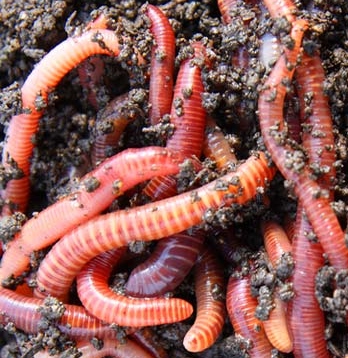Red wigglers: Enhance soil naturally
Red wigglers: Enhance soil naturally
Blog Article
Rise Soil Health And Wellness Naturally With Red Wigglers
The assimilation of red wigglers right into dirt administration practices provides a compelling method for boosting soil health normally. These earthworms not only transform organic waste into important vermicompost, but their natural behaviors likewise promote enhanced dirt structure, aeration, and vitamins and mineral schedule.
Benefits of Red Wigglers

Furthermore, red wigglers improve soil framework by creating networks as they tunnel through the earth. This activity enhances aeration and drain, facilitating origin development and ensuring that plants receive appropriate oxygen and wetness. Furthermore, the castings generated by red wigglers are high in nutrients such as nitrogen, phosphorus, and potassium, which are crucial for plant growth.
Red wigglers also aid in the decrease of dangerous microorganisms and insects by outcompeting them for sources, further adding to a healthier dirt setting. Their visibility can bring about a reduction in the requirement for artificial fertilizers and chemicals, promoting lasting agricultural practices. In general, incorporating red wigglers into soil monitoring strategies provides an all-natural and efficient methods of improving soil vitality, consequently sustaining robust plant development and farming efficiency.
Establishing Vermicomposting
Developing a vermicomposting system is a functional method to harness the impressive advantages of red wigglers in improving dirt health. red wigglers. To start, pick an appropriate container-- preferably, a plastic or wood container with a cover to keep dampness and temperature level. The bin must have drainage holes to protect against excess water accumulation
Next, prepare bed linens product, which offers as a habitat for the worms. Appropriate materials consist of shredded newspaper, cardboard, or coconut coir. Go for a deepness of 4-6 inches to give ample space for the worms.
When the bed linen is in area, present the red wigglers, usually at a ratio of one extra pound of worms for every square foot of area in the container. Following this, add kitchen area scraps such as vegetables and fruit peels, coffee grounds, and crushed eggshells. Stay clear of meat, dairy, and oily foods, as these can draw in bugs.
(red wiggler compost bin)
Caring for Your Worms
Keeping the health of your red wigglers is necessary for a thriving vermicomposting system. Appropriate treatment ensures that these helpful microorganisms can effectively damage down organic issue and enhance your dirt. Begin by supplying a proper habitat; a well-ventilated bin with a damp, dark setting is important. Purpose for a bed linen product that consists of shredded paper, cardboard, or coconut coir, which should be maintained wet however not saturated.
Feeding your worms is an additional vital facet of their care. Red wigglers flourish on kitchen scraps such as fruit and veggie peels, coffee grounds, and smashed eggshells.
Temperature level monitoring is vital; worms favor a series of 55 to 77 degrees Fahrenheit. Guarantee the bin is not revealed to route sunlight or severe cold. Routinely examine for indications of distress, such as extreme worm migration or uncommon odors, to resolve any kind of potential issues promptly. By following these standards, you will certainly foster a healthy and balanced ecological community for your red wigglers.
Utilizing Worm Castings in Soil
Worm spreadings, often described as "black gold," are an effective change that can substantially improve dirt health and wellness and fertility. red wigglers. These nutrient-rich, organic fertilizers are generated by red wigglers throughout their digestion procedure, leading to a finely textured product that is helpful for plants and soil alike
Integrating worm spreadings into your soil enhances its framework, boosting aeration and water retention. This is specifically helpful for sandy dirts that drain pipes as well quickly, in addition to hefty clay soils that can come to be compressed. Worm castings are loaded with important nutrients, consisting of nitrogen, phosphorus, and potassium, which are important for plant development.

Ultimately, making use of worm spreadings cultivates a thriving ecological community within the dirt, resulting in Lake James Worms much healthier plants and more sustainable horticulture practices.
Tips for Effective Composting
Effective composting calls for careful attention to a few key concepts that can significantly boost the quality of the final item. First, equilibrium is critical; keep a correct proportion of green materials (nitrogen-rich) to brownish products (carbon-rich), ideally around 1:3. This equilibrium facilitates efficient decay and decreases smells.
2nd, oygenation plays an essential duty. Frequently transforming the compost heap boosts oxygen circulation, which increases microbial task and quicken the composting procedure. Go for a stack size of at the very least three feet by 3 feet to preserve warm, which additionally advertises decay.
(red wiggler compost bin)
Dampness content is an additional important factor; the garden compost must be damp but not soaked. A good general rule is to attain a moisture level comparable to that of a wrung-out sponge. Too much water can cause anaerobic conditions, while inadequate can reduce down disintegration.
Lastly, keep track of the temperature level of the garden compost. A temperature series of 130 ° F to 160 ° F suggests energetic composting and helps eliminate virus and weed seeds. By adhering to these concepts, you will produce a nutrient-rich garden compost that sustains soil health and boosts plant growth.
Verdict
Integrating red wigglers into horticulture methods improves dirt health with all-natural processes. These worms add to the malfunction of organic products, resulting in nutrient-rich vermicompost that improves soil framework and fertility.
Report this page